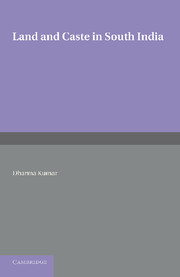 Land and Caste in South India
Land and Caste in South India Book contents
- Frontmatter
- Dedication
- CONTENTS
- List of Tables and Figures
- Acknowledgements and A Note on Certain Connventions
- Abbreviations
- Map of the Madras Presidency
- PART I
- PART II
- VII LAND AND POPULATION
- VIII EMIGRATION
- IX WAGES
- X THE GROWTH OF AGRICULTURAL LABOUR FROM 1871 TO 1901
- XI CONCLUSION
- Glossary
- Bibliography
- Index
VII - LAND AND POPULATION
from PART II
Published online by Cambridge University Press: 05 June 2016
- Frontmatter
- Dedication
- CONTENTS
- List of Tables and Figures
- Acknowledgements and A Note on Certain Connventions
- Abbreviations
- Map of the Madras Presidency
- PART I
- PART II
- VII LAND AND POPULATION
- VIII EMIGRATION
- IX WAGES
- X THE GROWTH OF AGRICULTURAL LABOUR FROM 1871 TO 1901
- XI CONCLUSION
- Glossary
- Bibliography
- Index
Summary
One of the crucial factors in the growth of landless labour is obviously the pressure of population on land as measured by changes in the land-labour ratio, this basic ratio being qualified by changes in technique and in crop patterns. But there are, of course, several other very important factors to be considered. As we have seen, the land revenue was particularly important in Madras; when the rate was very heavy, it may well have induced some cultivators to throw up their lands and to work as agricultural labourers. Another important factor may have been the decline of village industries or other avenues of employment. No quantitative information is available on this up to 1870 but thereafter the Censuses do contain some data on the change in the proportion of the agricultural population to total population; this will be discussed in Chapter X. Again changes in the terms of trade between agricultural and other commodities and changes in exports of agricultural commodities outside Madras were obviously relevant—particularly after the opening of the Suez Canal in 1869. But foreign trade in agricultural commodities is not of much significance here since the quantities exported were a small proportion of the total output of the Presidency.
The first estimate of population for Madras (in the British period at least) was made in 1687 but we need go back only as far as 1802 when the population was estimated at 9.57 millions. Estimates of population, including figures for each district, are also available for 1823,1827,1830 and 1839. These were compiled from the figures sent in by the Collectors and are likely to be far more reliable than the estimate for 1802, which included ‘in some cases calculations of population based on comparative revenues’. More and better census data are available for Madras than for any other part of India in this period, but even these censuses suffered from a number of grave defects, particularly the first two returns. Instead of taking an actual count of the inhabitants, the population was sometimes estimated by applying a certain ratio of persons per house to the number of houses. This method naturally led to grave mistakes.
- Type
- Chapter
- Information
- Land and Caste in South IndiaAgricultural Labour in the Madras Presidency during the Nineteenth Century, pp. 101 - 127Publisher: Cambridge University PressPrint publication year: 2013


